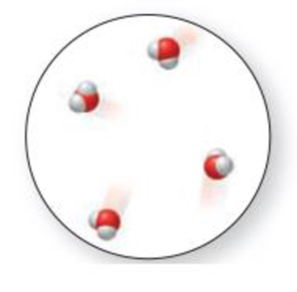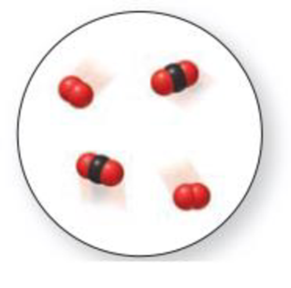
PRIN.OF GENERAL,ORGANIC+BIOLOG.CHEM.
2nd Edition
ISBN: 9781266811852
Author: SMITH
Publisher: MCG
expand_more
expand_more
format_list_bulleted
Concept explainers
Textbook Question
Chapter 1.3, Problem 1.4P
Classify each example of molecular art as a pure substance or a mixture:


Expert Solution & Answer
Want to see the full answer?
Check out a sample textbook solution
Students have asked these similar questions
None
Transmitance
3. Which one of the following compounds corresponds to
this IR spectrum?
Point out the absorption band(s) that helped you
decide.
OH
H3C
OH
H₂C
CH3
H3C
CH3
H3C
INFRARED SPECTRUM
0.8-
0.6
0.4-
0.2
3000
2000
1000
Wavenumber (cm-1)
4. Consider this compound:
H3C
On the structure above, label the different types of H's
as A, B, C, etc.
In table form, list the labeled signals, and for each
one state the number of hydrogens, their shifts, and the
splitting you would observe for these hydrogens in the ¹H
NMR spectrum.
Label
# of hydrogens
splitting
Shift (2)
None
Chapter 1 Solutions
PRIN.OF GENERAL,ORGANIC+BIOLOG.CHEM.
Ch. 1.1 - Imagine that your job as a healthcare professional...Ch. 1.2 - Characterize each process as a physical change or...Ch. 1.2 - Does the molecular art represent a chemical change...Ch. 1.3 - Classify each example of molecular art as a pure...Ch. 1.3 - Prob. 1.5PCh. 1.3 - Classify each item as an element or a compound:...Ch. 1.4 - Prob. 1.7PCh. 1.4 - If a nanometer is one billionth of a meter (0.000...Ch. 1.4 - Prob. 1.9PCh. 1.4 - Prob. 1.10P
Ch. 1.5 - How many significant figures does each number...Ch. 1.5 - Indicate whether each zero in the following...Ch. 1.5 - Prob. 1.13PCh. 1.5 - Carry out each calculation and give the answer...Ch. 1.5 - Prob. 1.15PCh. 1.6 - Prob. 1.16PCh. 1.6 - Prob. 1.17PCh. 1.6 - Prob. 1.18PCh. 1.7 - Prob. 1.19PCh. 1.7 - Prob. 1.20PCh. 1.7 - Prob. 1.21PCh. 1.7 - Carry out each of the following conversions. a....Ch. 1.8 - Prob. 1.23PCh. 1.8 - A patient is prescribed 0.100 mg of a drug that is...Ch. 1.8 - Prob. 1.25PCh. 1.9 - Prob. 1.26PCh. 1.9 - Prob. 1.27PCh. 1.10 - How does the mass of liquid A in cylinder [1]...Ch. 1.10 - Prob. 1.29PCh. 1.10 - Prob. 1.30PCh. 1 - Classify each example of molecular art as a pure...Ch. 1 - (a) Which representation(s) in Problem 1.31...Ch. 1 - When a chunk of dry ice (solid carbon dioxide) is...Ch. 1 - The inexpensive preparation of nitrogen-containing...Ch. 1 - a. What is the temperature on the given Fahrenheit...Ch. 1 - (a) What is the length of the given crayon in...Ch. 1 - Prob. 1.37UKCCh. 1 - Prob. 1.38UKCCh. 1 - Prob. 1.39UKCCh. 1 - Red light has a wavelength of 683 nm. Convert this...Ch. 1 - Prob. 1.41UKCCh. 1 - Prob. 1.42UKCCh. 1 - Prob. 1.43UKCCh. 1 - Prob. 1.44UKCCh. 1 - Label each component in the molecular art as an...Ch. 1 - Label each component in the molecular art as an...Ch. 1 - Describe solids, liquids, and gases in terms of...Ch. 1 - Prob. 1.48APCh. 1 - Prob. 1.49APCh. 1 - Classify each process as a chemical or physical...Ch. 1 - Which quantity in each pair is larger? a. 5 mL or...Ch. 1 - Which quantity in each pair is larger? a. 10 km or...Ch. 1 - Label each quantity as an exact or inexact number....Ch. 1 - Rank the quantities in each group from smallest to...Ch. 1 - How many significant figures does each number...Ch. 1 - Prob. 1.56APCh. 1 - Round each number to three significant figures. a....Ch. 1 - Prob. 1.58APCh. 1 - Prob. 1.59APCh. 1 - Prob. 1.60APCh. 1 - Prob. 1.61APCh. 1 - Prob. 1.62APCh. 1 - Prob. 1.63APCh. 1 - Prob. 1.64APCh. 1 - Prob. 1.65APCh. 1 - Rank the numbers in each group from smallest to...Ch. 1 - Write the recommended daily intake of each...Ch. 1 - Prob. 1.68APCh. 1 - Prob. 1.69APCh. 1 - Carry out each of the following conversions. a. 25...Ch. 1 - Prob. 1.71APCh. 1 - Prob. 1.72APCh. 1 - Prob. 1.73APCh. 1 - Prob. 1.74APCh. 1 - Prob. 1.75APCh. 1 - Prob. 1.76APCh. 1 - Prob. 1.77APCh. 1 - Prob. 1.78APCh. 1 - Prob. 1.79APCh. 1 - Prob. 1.80APCh. 1 - Prob. 1.81APCh. 1 - Prob. 1.82APCh. 1 - Which is the upper layer when each of the...Ch. 1 - Prob. 1.84APCh. 1 - A lab test showed an individuals cholesterol level...Ch. 1 - Prob. 1.86APCh. 1 - Liposuction is a cosmetic procedure used to remove...Ch. 1 - Prob. 1.88APCh. 1 - Prob. 1.89APCh. 1 - Prob. 1.90APCh. 1 - Prob. 1.91APCh. 1 - Prob. 1.92APCh. 1 - Prob. 1.93CPCh. 1 - Prob. 1.94CPCh. 1 - Prob. 1.95CPCh. 1 - Prob. 1.96CPCh. 1 - A soccer player weighed 70.7 kg before a match,...Ch. 1 - Prob. 1.98CP
Knowledge Booster
Learn more about
Need a deep-dive on the concept behind this application? Look no further. Learn more about this topic, chemistry and related others by exploring similar questions and additional content below.Similar questions
- Draw the Lewis structure of C2H4Oarrow_forwarda) 5. Circle all acidic (and anticoplanar to the Leaving group) protons in the following molecules, Solve these elimination reactions, and identify the major and minor products where appropriate: 20 points + NaOCH3 Br (2 productarrow_forwardNonearrow_forward
- Dr. Mendel asked his BIOL 260 class what their height was and what their parent's heights were. He plotted that data in the graph below to determine if height was a heritable trait. A. Is height a heritable trait? If yes, what is the heritability value? (2 pts) B. If the phenotypic variation is 30, what is the variation due to additive alleles? (2 pts) Offspring Height (Inches) 75 67.5 60 52.5 y = 0.9264x + 4.8519 55 60 65 MidParent Height (Inches) 70 75 12pt v V Paragraph B IUA > AT2 v Varrow_forwardExperiment: Each team will be provided with 5g of a mixture of acetanilide and salicylic acid. You will divide it into three 1.5 g portions in separate 125 mL Erlenmeyer flasks savıng some for melting point analysis. Dissolve the mixture in each flask in ~60mL of DI water by heating to boiling on a hotplate. Take the flasks off the hotplate once you have a clear solution and let them stand on the bench top for 5 mins and then allow them to cool as described below. Sample A-Let the first sample cool slowly to room temperature by letting it stand on your lab bench, with occasional stirring to promote crystallization. Sample B-Cool the second sample 1n a tap-water bath to 10-15 °C Sample C-Cool the third sample in an ice-bath to 0-2 °C Results: weight after recrystalization and melting point temp. A=0.624g,102-115° B=0.765g, 80-105° C=1.135g, 77-108 What is the percent yield of A,B, and C.arrow_forwardRel. Intensity Q 1. Which one of the following is true of the compound whose mass spectrum is shown here? Explain how you decided. 100 a) It contains chlorine. b) It contains bromine. c) It contains neither chlorine nor bromine. 80- 60- 40- 20- 0.0 0.0 TT 40 80 120 160 m/z 2. Using the Table of IR Absorptions how could you distinguish between these two compounds in the IR? What absorbance would one compound have that the other compound does not? HO CIarrow_forward
- Illustrate reaction mechanisms of alkenes with water in the presence of H2SO4, detailing each step of the process. Please show steps of processing. Please do both, I will thumb up for sure #1 #3arrow_forwardDraw the following molecule: (Z)-1-chloro-1-butenearrow_forwardIdentify the molecule as having a(n) E, Z, cis, or trans configuration. CH3 H₁₂C ○ E ○ z ○ cis transarrow_forward
- Identify the molecule as having a(n) E, Z, cis, or trans configuration. H₂C- CH3 О Е ○ cis ○ transarrow_forwardThe decomposition of dinitrogen pentoxide according to the equation: 50°C 2 N2O5(g) 4 NO2(g) + O2(g) follows first-order kinetics with a rate constant of 0.0065 s-1. If the initial concentration of N2O5 is 0.275 M, determine: the final concentration of N2O5 after 180 seconds. ...arrow_forwardDon't used hand raitingarrow_forward
arrow_back_ios
SEE MORE QUESTIONS
arrow_forward_ios
Recommended textbooks for you
- Chemistry: Matter and ChangeChemistryISBN:9780078746376Author:Dinah Zike, Laurel Dingrando, Nicholas Hainen, Cheryl WistromPublisher:Glencoe/McGraw-Hill School Pub Co

 Introductory Chemistry: A FoundationChemistryISBN:9781337399425Author:Steven S. Zumdahl, Donald J. DeCostePublisher:Cengage Learning
Introductory Chemistry: A FoundationChemistryISBN:9781337399425Author:Steven S. Zumdahl, Donald J. DeCostePublisher:Cengage Learning  World of Chemistry, 3rd editionChemistryISBN:9781133109655Author:Steven S. Zumdahl, Susan L. Zumdahl, Donald J. DeCostePublisher:Brooks / Cole / Cengage Learning
World of Chemistry, 3rd editionChemistryISBN:9781133109655Author:Steven S. Zumdahl, Susan L. Zumdahl, Donald J. DeCostePublisher:Brooks / Cole / Cengage Learning Chemistry for Today: General, Organic, and Bioche...ChemistryISBN:9781305960060Author:Spencer L. Seager, Michael R. Slabaugh, Maren S. HansenPublisher:Cengage Learning
Chemistry for Today: General, Organic, and Bioche...ChemistryISBN:9781305960060Author:Spencer L. Seager, Michael R. Slabaugh, Maren S. HansenPublisher:Cengage Learning

Chemistry: Matter and Change
Chemistry
ISBN:9780078746376
Author:Dinah Zike, Laurel Dingrando, Nicholas Hainen, Cheryl Wistrom
Publisher:Glencoe/McGraw-Hill School Pub Co


Introductory Chemistry: A Foundation
Chemistry
ISBN:9781337399425
Author:Steven S. Zumdahl, Donald J. DeCoste
Publisher:Cengage Learning

World of Chemistry, 3rd edition
Chemistry
ISBN:9781133109655
Author:Steven S. Zumdahl, Susan L. Zumdahl, Donald J. DeCoste
Publisher:Brooks / Cole / Cengage Learning


Chemistry for Today: General, Organic, and Bioche...
Chemistry
ISBN:9781305960060
Author:Spencer L. Seager, Michael R. Slabaugh, Maren S. Hansen
Publisher:Cengage Learning
Types of Matter: Elements, Compounds and Mixtures; Author: Professor Dave Explains;https://www.youtube.com/watch?v=dggHWvFJ8Xs;License: Standard YouTube License, CC-BY